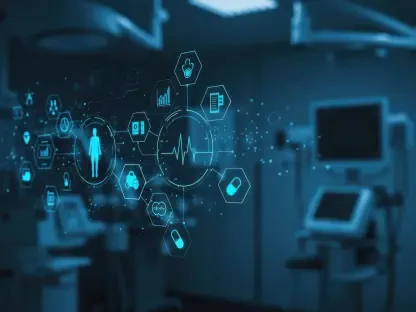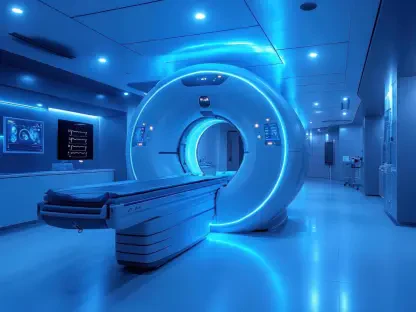Introduction to a Growing Cybersecurity Crisis in Healthcare
Imagine a scenario where the most personal and sensitive information of nearly half a million women is exposed in a single cyberattack, shattering trust in a critical healthcare system and exposing systemic vulnerabilities. This is the reality faced by the Netherlands, where a major breach at Clinical Diagnostics NMDL, a laboratory integral to the national cervical cancer screening program, has exposed the data of 485,000 women. The incident, involving the theft of over 300 gigabytes of personal and medical records, underscores a disturbing trend in the healthcare industry: the escalating vulnerability to cybercrime. As medical data becomes a prime target for hackers, this report delves into the specifics of the attack, systemic weaknesses, regulatory responses, and the urgent need for reform in an increasingly digitized sector.
Background of the Cyberattack on Clinical Diagnostics NMDL
Clinical Diagnostics NMDL plays a pivotal role in the Netherlands’ efforts to combat cervical cancer through widespread screening programs. The laboratory handles vast amounts of sensitive information, making it a high-value target for cybercriminals. In a devastating breach, hackers infiltrated its systems, compromising the privacy of nearly half a million women whose data was stored there.
The scale of this incident is staggering, with over 300 gigabytes of data stolen, encompassing critical details such as names, addresses, dates of birth, citizen service numbers, and medical test results. This breach not only jeopardizes individual privacy but also raises serious questions about the security protocols in place at institutions handling such delicate information. The fallout from this event continues to reverberate through the healthcare sector, highlighting the risks tied to digital record-keeping.
Details of the Breach and Hackers’ Tactics
Methods Used by the Nova Group
The hacking group known as “Nova” orchestrated this sophisticated attack, gaining unauthorized access to a treasure trove of personal and medical data at Clinical Diagnostics NMDL. Their approach likely exploited weaknesses in the laboratory’s digital infrastructure, though specific entry points remain under investigation. What is clear is the precision with which they extracted sensitive records, affecting a vast number of individuals.
To demonstrate the extent of their control, Nova released a sample dataset online, exposing the details of over 50,000 women. This calculated move served as both proof of their access and a chilling warning to authorities, amplifying the urgency of the situation. The public disclosure of such data, including information about vulnerable individuals, has heightened fears of potential misuse and exploitation.
Ransom Demand and Threats
Adding to the severity of the breach, Nova issued a ransom demand of 11 bitcoins, equivalent to approximately $1.28 million, with a strict deadline of August 28. Failure to meet this demand, they warned, would result in the full publication of the stolen data, a threat that could devastate the lives of those affected. This ultimatum has placed immense pressure on both the laboratory and Dutch authorities.
The looming possibility of widespread data exposure has intensified concerns among health officials and privacy advocates. The potential consequences of such a leak include identity theft, blackmail, and severe emotional distress for the victims. This situation exemplifies the high stakes of cyber extortion in the healthcare domain, where data holds both personal and financial value.
Vulnerabilities in Healthcare Cybersecurity
The healthcare industry across Europe faces a growing wave of cyber threats, with digitized medical records becoming a lucrative target for criminals. The high value of such data on illicit markets, often used for fraud or coercion, drives relentless attacks on institutions like Clinical Diagnostics NMDL. This incident serves as a stark reminder of the sector’s exposure to sophisticated hacking schemes.
Cybersecurity experts have pointed to systemic shortcomings in protecting sensitive information, particularly at the affected laboratory. Inadequate safeguards, outdated systems, and insufficient staff training are often cited as contributing factors. Analysts warn that without comprehensive upgrades to digital defenses, similar breaches will continue to plague the industry, eroding public trust.
A broader trend reveals that a single point of failure can compromise an entire network, as seen in this case. The interconnected nature of healthcare systems means that vulnerabilities at one facility can have far-reaching implications. Addressing these gaps requires not only technological investment but also a cultural shift toward prioritizing cybersecurity at every level of operation.
Regulatory Response and Compliance Issues
In the wake of the breach, the Dutch privacy watchdog, Autoriteit Persoonsgegevens, initiated a thorough investigation to determine whether Clinical Diagnostics NMDL complied with European data protection laws. These regulations mandate that breaches be reported within 72 hours and that affected individuals are notified promptly. The scrutiny focuses on whether the laboratory met these stringent requirements.
Criticism has mounted over the delayed communication following the incident, with reports suggesting it took nearly a month for full disclosure to reach the public. Such delays likely exacerbated the impact on victims, who were left unaware of the risks to their personal information. This lag in response has fueled debates about accountability and transparency in crisis management.
The regulatory probe also examines the broader implications for compliance across the healthcare sector. Ensuring adherence to data protection standards is critical to preventing future incidents, yet enforcement remains inconsistent. The findings of this investigation could set important precedents for how similar cases are handled moving forward, potentially shaping policy in the Netherlands and beyond.
Complexities of Ransom Negotiations and Public Backlash
A complicating factor in this breach is Nova’s assertion that Clinical Diagnostics violated a previous ransom agreement by involving law enforcement, prompting the current escalation. This claim introduces a murky dynamic to the situation, illustrating the ethical and practical dilemmas of engaging with cybercriminals. Negotiations in such scenarios are fraught with risks, including further breaches of trust.
Public and expert opinion has been sharply critical of both the laboratory and Dutch authorities for their handling of the crisis. Many argue that preventive measures were insufficient, leaving the door open to such a massive data theft. The slow pace of response has further eroded confidence in the ability of institutions to protect sensitive information.
This incident highlights the broader challenges of balancing law enforcement involvement with the immediate needs of victims during ransom situations. The backlash reflects a growing frustration with systemic failures that allow cybercriminals to exploit vulnerabilities. Addressing these concerns requires a coordinated approach that prioritizes both security and public trust.
Implications and the Path Forward
The breach at Clinical Diagnostics NMDL carries profound implications for the privacy and safety of nearly 485,000 women, many of whom are in vulnerable circumstances. The exposure of personal and medical data poses risks ranging from identity theft to psychological harm, particularly for those in protective environments like shelters. The scale of this incident underscores the human cost of cybersecurity failures.
Looking at trends over the current and upcoming years, from 2025 to 2027, the healthcare sector must prioritize robust cybersecurity frameworks to prevent similar incidents. Investments in advanced encryption, regular system audits, and employee training are essential to fortify defenses. Collaboration between public and private entities can also drive innovation in protecting sensitive data.
The ongoing investigation by Dutch authorities and the persistent threat of full data disclosure by Nova keep the stakes high. This crisis serves as a call to action for systemic reforms, emphasizing the need for faster breach responses and stricter compliance with data protection laws. The healthcare industry must adapt to the digital age by building resilient systems that safeguard patient information against evolving cyber threats.
Reflecting on a Critical Turning Point
Reflecting on the aftermath of the cyberattack on Clinical Diagnostics NMDL, it became evident that the incident marked a pivotal moment for the healthcare sector in the Netherlands. The breach exposed deep-seated vulnerabilities that had long been overlooked, prompting intense scrutiny of existing security practices. It also revealed the devastating personal impact on hundreds of thousands of women whose trust was shattered.
Moving forward, actionable steps taken included a push for legislative changes to enforce stricter cybersecurity standards across medical institutions. Partnerships with technology firms were forged to develop cutting-edge solutions tailored to healthcare needs. Additionally, public awareness campaigns were launched to educate individuals on protecting their data, empowering them in an era of digital risks.
The lessons learned from this crisis paved the way for a renewed commitment to safeguarding sensitive information. Industry leaders and policymakers collaborated to establish rapid-response protocols for future breaches, ensuring transparency and accountability. Ultimately, the path ahead focused on transforming this setback into a catalyst for enduring change, prioritizing the security and dignity of every patient.









